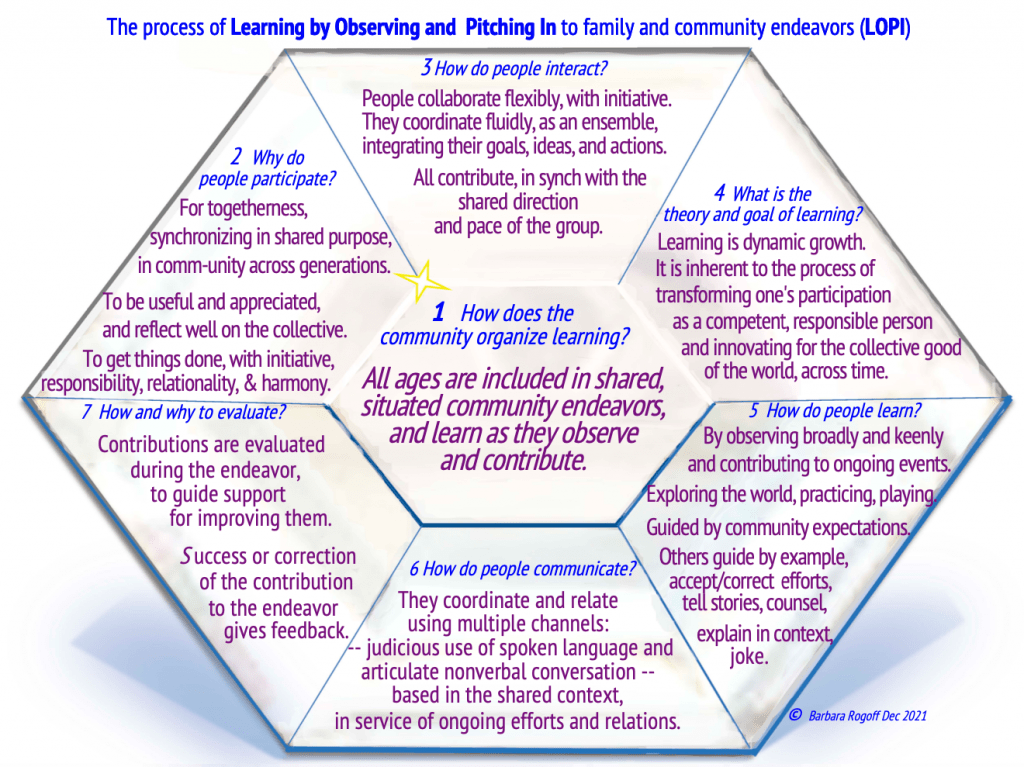Learning by Observing and Pitching In (LOPI) is a multifaceted approach to learning based on children observing and contributing collaboratively in the endeavors of their family and community. (LOPI was previously referred to as learning through Intent Community Participation.) LOPI is a distinct paradigm from the common approach referred to as Assembly-Line Instruction.
LOPI is defined by the 7 facets of the LOPI prism, which are each described below, along with links to relevant references.
General descriptions of LOPI are available in the following publications and in several LOPI videos.
(see Rogoff, Aceves-Azuara & Dayton, 2017; Rogoff, Callanan, Gutierrez & Erickson, 2016;Rogoff, 2016; Rogoff, 2014; Coppens, Silva, Ruvalcaba, Alcalá, López, & Rogoff, 2014; Rogoff, Alcalá, Coppens, López, Ruvalcaba, & Silva, 2014; Rogoff, Najafi, & Mejía-Arauz, 2014; Dayton & Rogoff, 2013; Rogoff, 2012; Paradise & Rogoff, 2009; Rogoff, Moore, Najafi, Dexter, Correa-Chávez, & Solís, 2007; Rogoff, Paradise, Mejía-Arauz, Correa-Chávez, & Angelillo, 2003)
1. How does the community organize learning?
All ages are included in shared, situated community endeavors, and learn as they observe and contribute.
(see;Urrieta, 2015; Flores, Urrieta, Chamoux, Fernández, López, 2015; Cardoso Jiménez, 2015; Remorini, 2015; Chamoux, 2015; Gutiérrez, Rosengren, & Miller, 2015; Fernández, 2015; Mejia-Arauz, Correa-Chavez, Ohrt, & Aceves-Azuara, 2015; Alcalá, Rogoff, Mejía-Arauz, Coppens, & Dexter, 2014; Alcalá, Rogoff, Mejía-Arauz, Coppens, & Roberts, 2014; Coppens, Alcalá, Mejía-Arauz, & Rogoff, 2014; Good Eshelman,2013;Rogoff, 2011; Corona, 2011; Orellana, 2003; Rogoff, 2003; Corona, 2001; Gaskins, 2000; Rogoff, Mistry, Göncü, & Mosier, 1993)
2. Why do people participate?
For togetherness, synchronizing in shared purpose, in comm-unity across generations. To be useful and appreciated, and reflect well on the collective. To get things done, with initiative, responsibility, relationality, & harmony.
(see: Coppens & Rogoff, 2021; Murray, Bowen, Segura, & Verdugo, 2015; Adair, 2015; Remorini, 2015; Gutiérrez, Rosengren, & Miller, 2015; de León, 2015; García, 2015; Martínez-Pérez, 2015; Coppens & Alcalá 2015; Fernández, 2015; Mejia-Arauz, Correa-Chavez, Ohrt, & Aceves-Azuara, 2015;Coppens, Silva, Ruvalcaba, Alcalá, López, & Rogoff, 2014; Alcalá, Rogoff, Mejía-Arauz, Coppens, & Roberts, 2014; Coppens, Alcalá, Mejía-Arauz, & Rogoff, 2014; Orellana, 2003; Corona, 2001; Rogoff, Goodman Turkanis, & Bartlett, 2001; Gaskins, 2000)
3. How do people interact?
People collaborate flexibly, with initiative. They coordinate fluidly, as an ensemble, integrating their goals, ideas, and actions. All contribute, in synch with the shared direction and pace of the group.
(see: Dayton, Aceves-Azuara, & Rogoff, 2022; Alcalá, Rogoff, & Fraire, 2018; Correa-Chávez, Mangione & Mejía-Arauz, 2016; Murray, Bowen, Segura, & Verdugo, 2015; Flores, Urrieta, Chamoux, Fernández, López, 2015; Bang, Marin, Medin, Washinawatok, 2015;Cardoso Jiménez, 2015; Remorini, 2015; Gutiérrez, Rosengren, & Miller, 2015; Ruvalcaba, Rogoff, López, Correa-Chávez & Gutiérrez, 2015; de León, 2015; Martínez-Pérez, 2015; Fernández, 2015; Mejia-Arauz, Correa-Chavez, Ohrt, & Aceves-Azuara, 2015; López, Ruvalcaba & Rogoff; 2015; Coppens, Silva, Ruvalcaba, Alcalá, López, & Rogoff, 2014; Alcalá, Rogoff, Mejía-Arauz, Coppens, & Roberts, 2014; Coppens, Alcalá, Mejía-Arauz, & Rogoff, 2014; Paradise, Mejía-Arauz, Silva, Dexter, & Rogoff, 2014; Mejía-Arauz, Roberts & Rogoff, 2012; Roberts & Rogoff, 2012; López, Rogoff, Nafaji, Mejía-Arauz, 2012; Silva, Correa-Chavez, & Rogoff, 2010; López, Correa-Chávez, Rogoff, & Gutiérrez, 2010; Paradise, & De Haan, 2009; Chavajay, 2008; Mejia Arauz, Rogoff, Dexter, & Najafi, 2007; Chavajay, 2006; Orellana, 2003; Rogoff, 2003; Chavajay, & Rogoff, 2002; Corona, 2001; Rogoff, Goodman Turkanis, & Bartlett, 2001; Rogoff, Mistry, Göncü, & Mosier, 1993; Rogoff, Mosier, Mistry, & Goncu, 1993)
4. What is the theory and goal of learning?
Learning is dynamic growth. It is inherent to the process of transforming one's participation as a competent, responsible person and innovating for the collective good of the world, across time.
(see : Rosado-May, Urrieta Jr, Dayton, & Rogoff, 2020; Alcalá, Rogoff, & Fraire, 2018;Dayton & Rogoff, 2016; Urrieta, 2015; Flores, Urrieta, Chamoux, Fernández, López, 2015; Cardoso Jiménez, 2015; Remorini, 2015; Ruvalcaba, Rogoff, López, Correa-Chávez & Gutiérrez, 2015; García, 2015; Fernández 2015; López, Ruvalcaba & Rogoff; 2015; Alcalá, Rogoff, Mejía-Arauz, Coppens, & Roberts, 2014; Coppens, Alcalá, Mejía-Arauz, & Rogoff, 2014; López, Rogoff, Nafaji, Mejía-Arauz, 2012; Corona, 2011; Paradise, & De Haan, 2009; Mejia Arauz, Rogoff, Dexter, & Najafi, 2007; Lorente, 2006; Orellana, 2003; Corona, 2001; Rogoff, Goodman Turkanis, & Bartlett, 2001; Gaskins, 2000)
5. How do people learn?
By observing broadly and keenly and contributing to ongoing events. Exploring the world, practicing, playing. Guided by community expectations. Others guide by example, accept/correct efforts, tell stories, counsel, explain in context, joke.
(see: Silva & Rogoff, 2020; Mejía Arauz, Dexter, Rogoff, & Aceves-Azuara, 2019; Urrieta, 2015; Flores, Urrieta, Chamoux, Fernández, López, 2015; Cardoso Jiménez, 2015; Chamoux, 2015; Gutiérrez, Rosengren, & Miller, 2015; Silva, Shimpi, & Rogoff, 2015; de León, 2015; García, 2015; Martínez-Pérez, 2015;Paradise, Mejía-Arauz, Silva, Dexter, & Rogoff, 2014;Tsethlikai & Rogoff, 2013; López, Rogoff, Nafaji, Mejía-Arauz, 2012; Correa-Chávez, Roberts, & Martinez, 2011; Rogoff, 2011; López, Correa-Chávez, Rogoff, & Gutiérrez, 2010; Silva, Correa-Chavez, & Rogoff, 2010; Lorente, 2006; Rogoff, 2003; Gaskins, 2000; Rogoff, Mistry, Göncü, & Mosier, 1993; Rogoff, Mosier, Mistry, & Goncu, 1993)
6. How do people communicate?
They coordinate and relate using multiple channels: - judicious use of spoken language and articulate nonverbal conversation -- based in the shared context, in service of ongoing efforts and relations.
(see: Henne–Ochoa, Elliott–Groves, Meek, & Rogoff , 2020; Correa-Chávez, Mangione & Mejía-Arauz, 2016; de León, 2015; García, 2015; Martínez-Pérez, 2015; Mejía-Arauz, Roberts & Rogoff, 2012; Roberts & Rogoff, 2012; López, Rogoff, Nafaji, Mejía-Arauz, 2012; Chavajay, 2008; Mejía-Arauz, Rogoff, Dexter, & Najafi, 2007; Chavajay, 2006; Lorente, 2006; Rogoff, 2003; Rogoff, Mistry, Göncü, & Mosier, 1993; Rogoff, Mosier, Mistry, & Goncu, 1993)
7. How and why to evaluate?
Contributions are evaluated during the endeavor, to guide support for improving them. Success or correction of the contribution to the endeavor gives feedback.
